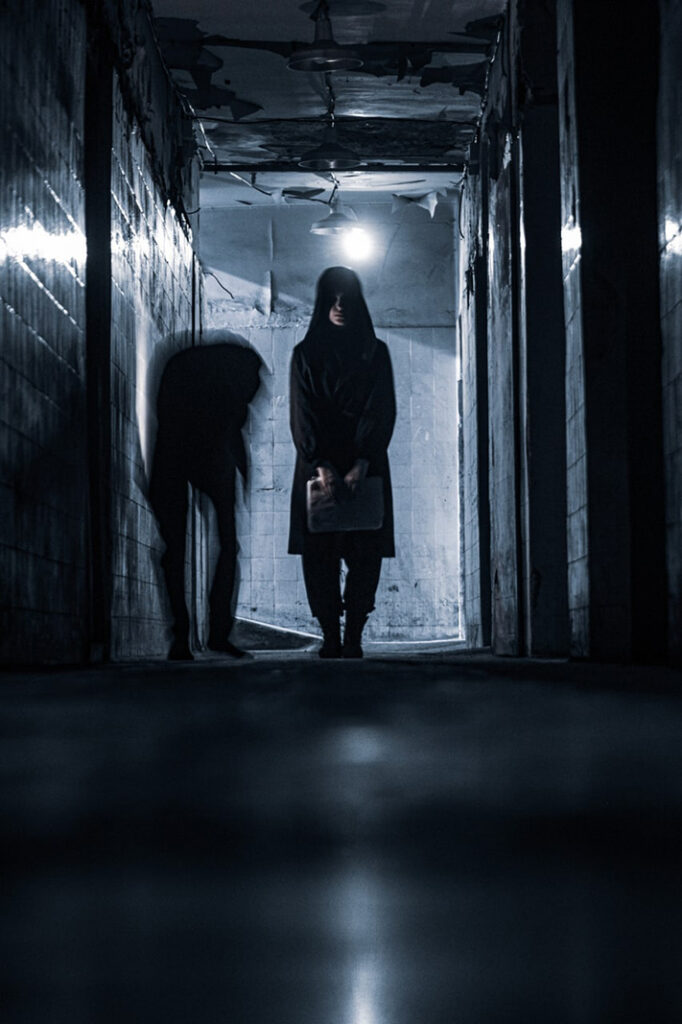A site-specific experimental theater
Written and directed by Ali Ettehad
Tehran, Iran
2022
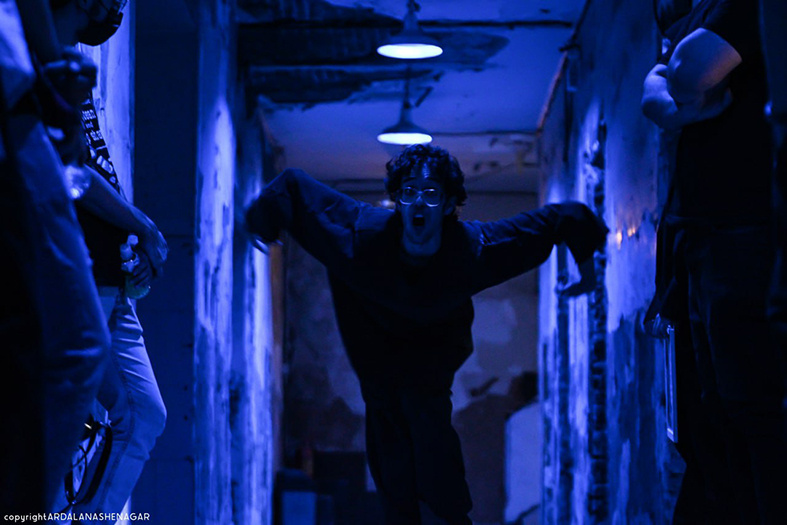
Photos by Ardalan Ashnagar
“Letters Hitched by Wind” is a work that is designed based on the expressive possibilities of performance-art, theater, music, installatio n-art, video-art, interactive-art, dance, ritual and literature. Ali Ettehad, the writer and director of this piece, made this work based on a novel written by himself.
Ali Ettehad: I finished writing the novel “Letters Hitched by Wind” in the late 2017 and it was published in the same year. The novel has four narrators, whose narrations are written in a different font in the book.

Ali Ettehad: The story is that the first character of the novel accidentally finds a broken clay tablet in his garden with a text written on it. The text on the tablet is damaged and difficult to read. The first narrator succeeds in reading the script after many attempts and digs the corners of his garden to find the rest of it. However, months pass and he find nothing. Months later when he goes to see an ancient caravanserai – hundreds of kilometers away from his garden – A brick is fallen from the dome and falls on the ground; The brick is covered by scripts. The text on the brick is a continuation of the text on the tablet and the story continues slowly as other pieces of manuscript are found. It is obvious that one of the narrators is the one who wrote these texts. Gradually, the author of the texts and the finder become one soul. In the second half of the novel, the manuscripts of the first narrator and the found texts of the second narrator – edited by the first narrator – reach the hands of an author who has not written anything new in two past years. The papers are placed in a yellow and old envelope, and there is no address written nor is there a post office stamp on it. The author starts reading the texts and slowly his life is influenced by the concept of the manuscripts. A little later, he becomes so involved in the texts in the yellow envelope that he feels the presence of the author of those texts in his home. After some time, he leaves that house and almost dies, but he is saved and goes into a coma for about two months. When the author comes out of the coma, he himself remembers something about the incident that might have led to his death, and others something else. And at the end, when he returns home, all traces of both forms of narration of his near-death experience are present. He doesn’t know which one to believe. Finally, he dreams and decides to do what he dreamed. He dreamed that somewhere, under an oak tree, by a river, he buries a yellow envelope so that one day someone might find it.
What is written above is the summary of the novel and despite all this, this story was performed in a complex and intertwined way in the show. Most of my works are site-specific, because of that, I have to start the description of the performance “Letters Hitched by Wind” from the venue.
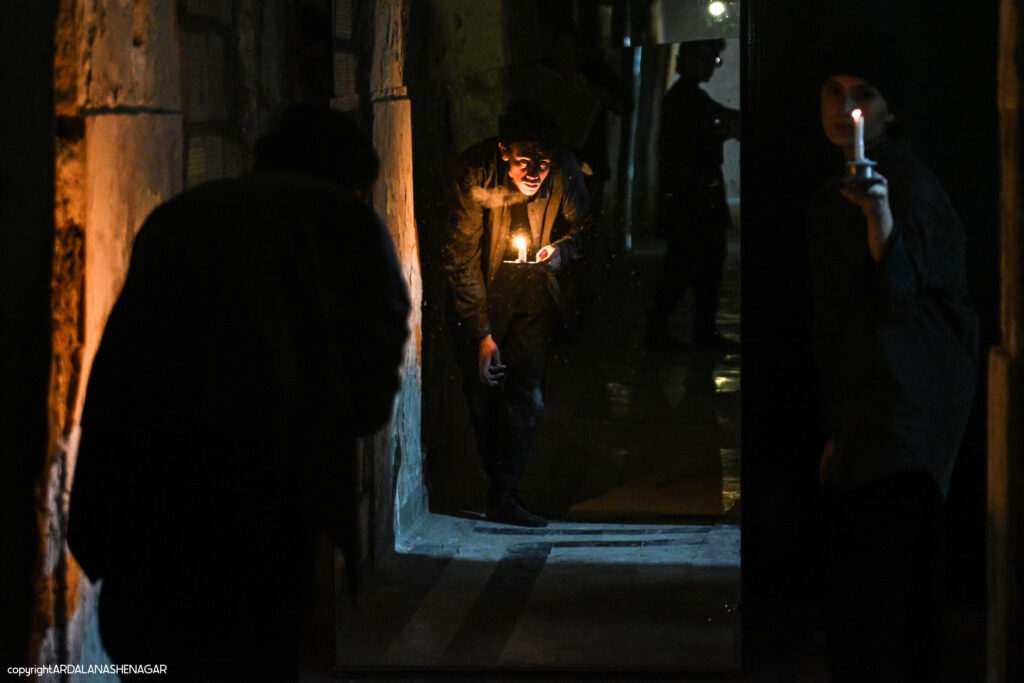
Ali Ettehad: The first private hospital in Tehran was established almost eighty years ago. About fifty years ago, this hospital was repaired and changed its use and became a maternity hospital named “Omid” (means “Hope” in Farsi). This place was confiscated after Iran’s revolution (1979) and slowly abandoned and destroyed. Forty years later, “Hope” maternity hospital became a venue for performing arts. When the manager of this theater invited me to design my new theater piece in this historic building, it had not yet opened. I was watching the building when I became sure that I should make a performance piece based on my novel “Letters Hitched by Wind”. I decided to divide the different aspects of the character of the four narrators and let each of them be played by an individual performer. Seventeen different pieces arranged on different floors of the building together create a dream-like experience; Something like walking through different layers of consciousness and subconsciousness of the writer. When one writes, images do not come gradually; Most of the scenes appear simultaneously and intertwined in the scene of the author’s mind. Everything is simultaneous in this theater. The scenes are not performed one by one, but each scene is performed on each floor, and it is the presence of the audience that creates the lead and the lag. Like most of my works, this piece uses different smells. One floor smells of sandalwood, one of darshan, one of Chandan and one of candle wax. These smells mingled in the stairways and corridors and created new smells. At the same time, you have to imagine that these smells were combined with the old smell of the building and wet soil. The sounds were designed to be intertwined in the same way. The audience could hear something muffled by the sound of other floors from each floor. These sounds started from the lowest level in each floor and gradually got louder and louder. In this way, if the audience was watching a noisy scene, other audiences would also experience such a moment. All these seventeen scenes were designed with clockwork coordination.
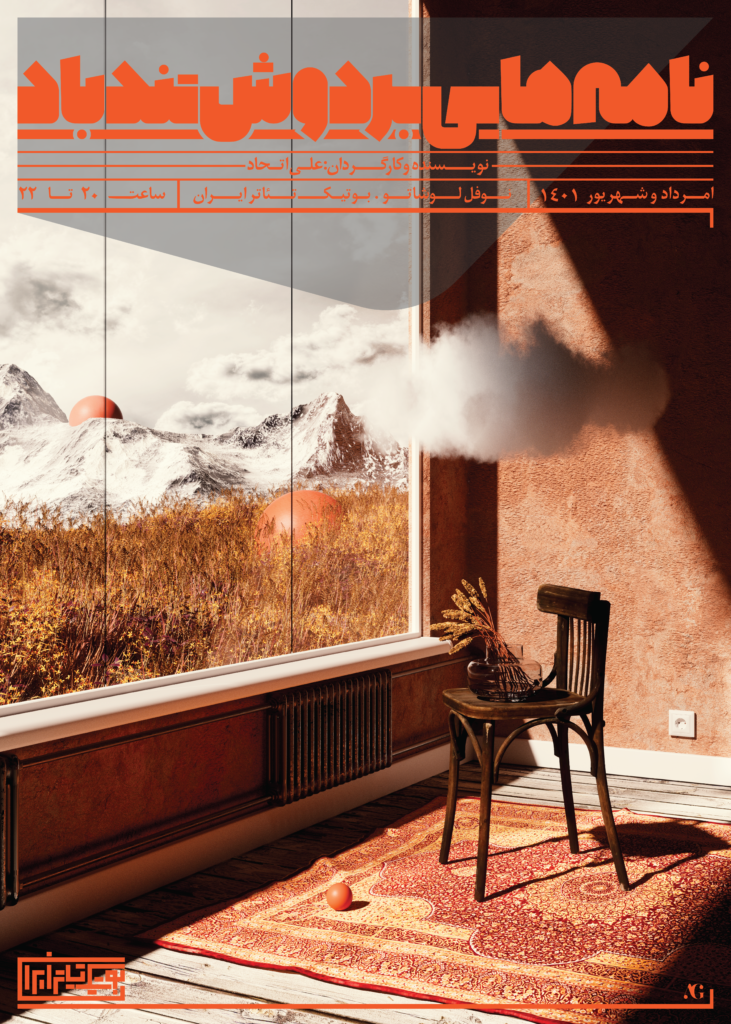
The official poster of the show designed by Ashkan Galedari
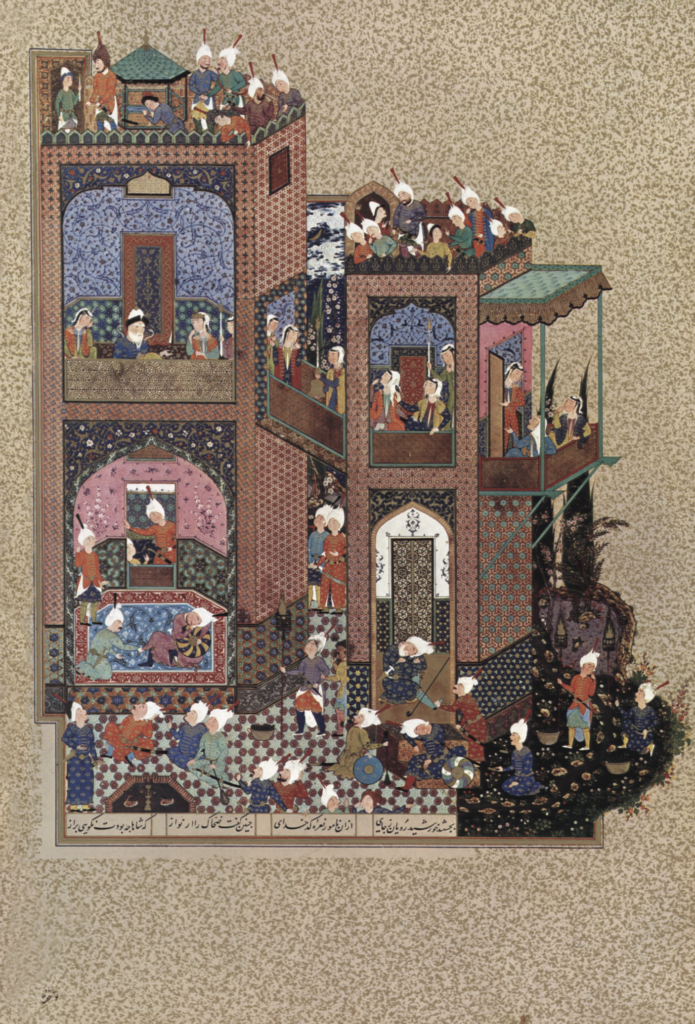
Zahhak, in Iranian mythology, is an oppressive figure who rules Iran for a millennium. He marries two daughters of the former king of Iran. At the end of this millennium, Fereydoun is born and grows up to become a hero who pulls Zahhak down from the throne.
Dhahak has a terrible dream at night and wakes up from the horror of it.Hearing this cry, his women wake up and go to the dream interpreter to come and inform Dhahak about the meaning of his dream.
This illustration is from the famous Shahnameh of Shah Tahmasp I (r.1524-1576 AD). In this painting, Shahrnaz and Arnawaz (Zahhak’s wives) are depicted once in Zahhak’s bed, once in the corridor outside the chamber, once with other women, once in conversation with others and once in the balcony. Soldiers and other people in the picture are also looking at this scene from other floors or at least turned towards the sound. Character repetition in painting, in order to advance the narrative line, has a long history in Iranian painting. Ali Ettehad, by looking at the ancient art methods of Iran, by spreading one character among several performers, has placed different layers of narration in different floors of the building.

For example, in the this master piece by Kamal-ud-Din Behzad, based on a story by Attar; We see the steps of burying a body. These steps tell the story from bottom to top, and if we look at it in a different order, they will say new things. This model of narration is exactly what Ettehad used in his show.
Ali Ettehad: Old Iranian plays are often based on monologues and most rituals in the world are like this. Dramatic forms such as Pardeh Show, Ta’ziyeh and impersonation are all ritualistic and they are all made on the basis of monologue.

The Writer (at the entrance of White Floor): Matin Mokari Moghaddam
Before the audience enters the building; Somewhere right next to the entrance steps, a performer was walking. The performer performed a short monologue, which is like the prologue of the book. After the performer finished the prologue, the guide of the same color as the audience’s tickets would approach and take the audience to one of the floors.

Guides: Paria Minabi, Saba Ghorbanpour, Zoha Esmailfar and Dina Mirzaie
The audience entrance cards were made in four colors and were given to the audience upon entering; Red, blue, green and yellow. Upon entering the building and after the first monologue (The Writer), the audience would be accompanied by the guidance of the same color as their cards; Each guide’s face was painted in one of these four colors.
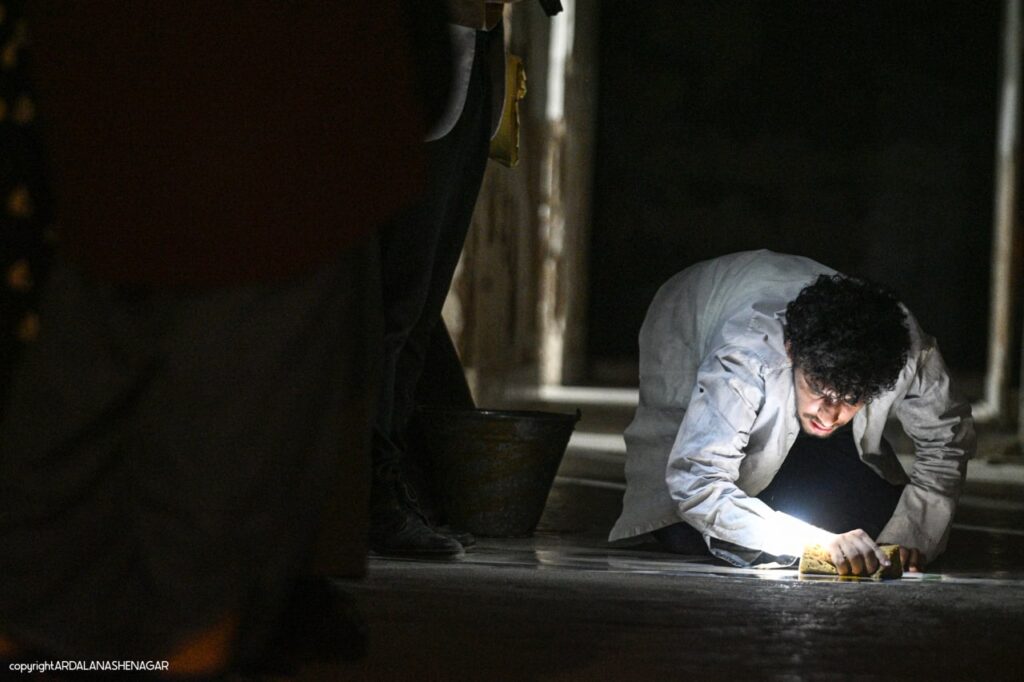
The Deckhand (in the White Floor): Amir Mohammad Sadeghi
The Deckhand was sitting in the middle of the corridor of the white floor; With a sponge in his hand and a bucket of water by his side, he slowly and silently scrubs the floor. Whenever the audience passed by him, he would wipe their footsteps. As the audience passed by the Deckhand, he would start his monologue.


A man with the yellow envelope (in the White Floor): Nima Abedi Khiaban
“A man with a yellow envelope” is a realistic image of the writer; the same writer who receives handwritten and typed sheets in a yellow envelope in the second half of the novel and tries to analyze and recognize what is written and write its description.
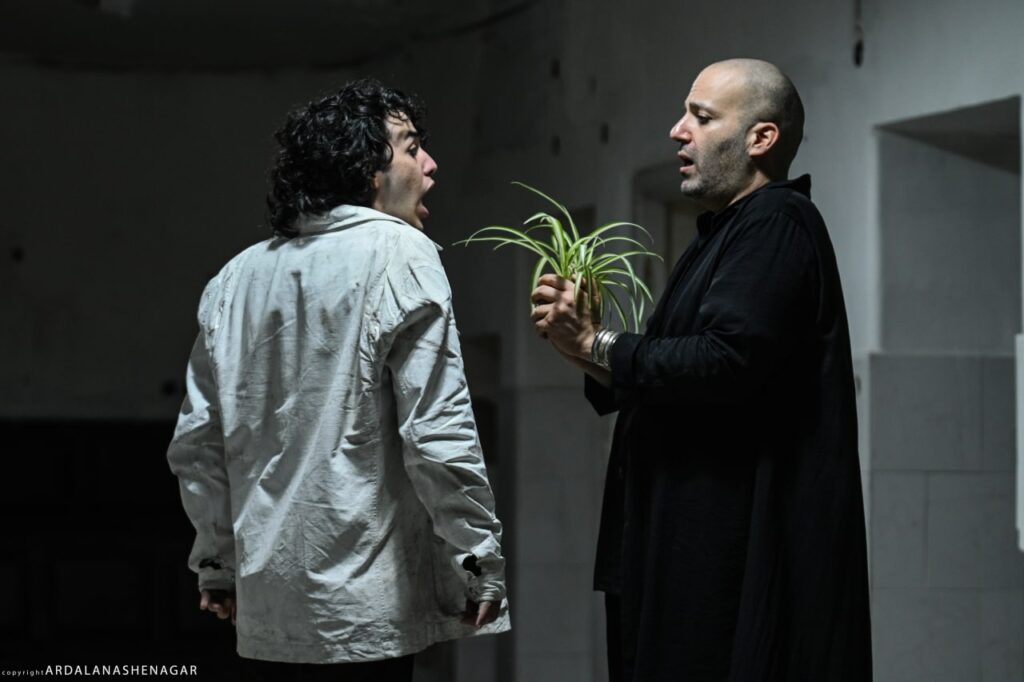
This part of the performance is designed with the elements of “Zaar”- an ancient form of mystical healing from South of Iran – some details of the dance, musical instrument, the music it-self and outfits are all reminders of this ancient ritual. Although elements and details come from the past, but its execution method is derived from contemporary dance methods.
In this part, the monologue gradually turned into a vocal duet sung by two tenor and baritone performers.

The Damam player: Alinour Yousefi
In “People of Air” scene, Damam* plays a central role in the music background. At the beginning, he starts with single beats and little by little the music and dance go hand in hand until the beat reaches its most complex part and completes the dance scene.
* Damam is one of the percussion instruments in the classification of Persian instrumental ethnic repertoire. It sounds with the oscillation of the skin and is placed in the category of cylindrical percussion instruments. Dammam is more common in the south of Iran, especially in Bushehr province and other southern regions.
Read more about “People of Air” and ZĀR traditions from Encyclopaedia Iranica (complete article) :
ZĀR, harmful wind (bād) associated with spirit possession beliefs in southern coastal regions of Iran.
In southern coastal regions of Iran such as Qeshm Island, people believe in the existence of winds that can be either vicious or peaceful, believer (Muslim) or non-believer (infidel). The latter are considered more dangerous than the former and zārbelongs to this group of winds. Many varieties of zār are known, including Maturi, Šayḵ Šangar, Dingemāru, Omagāre, Bumaryom, Pepe, Bābur, Bibi, and Namrud (Sāʿedi, pp. 57; Interviews, 2007, 2009). Most types of zār are very dangerous and cause disease, discomfort, and at times serious illnesses for the victim. Everyone is subject to the action of the zār, but the poor and the deprived seem to be the most common victims. Zārs are also considered contagious; for example, when people love or hate one another, they can give their zār to those whom they love or hate. The belief is that one can never get rid of zārs, but can only come to terms with them to leave the victim alone. These beliefs are common to many areas in south and southwest Iran, including Baluchistan where harmful winds are usually called Gowat (‘wind’ or ‘air’; Riāḥi; Darviši).
Special ceremonies are held to pacify the zār and alleviate the patient’s symptoms. These ceremonies, called by a leader, bring together the patient and those previously afflicted by the zār and involve incense, music, and movement. The details of the ceremony differ according to location and have undergone changes with the passage of time (Sāʿedi, pp. 42-52; Taqvāʾi, 1999; Bāzmāndegān Qešmi). While Ḡolām-Ḥosayn Sāʿedi (q.v) reported the practice of this ceremony along the coast of the Persian Gulf, from Bušehr to Bandar-e Lenga in 1961, at the time of this research, zār was no longer practiced in certain locations such as Bušehr and observed far more actively in Qeshm Island than in Bandar ʿAbbās. Furthermore, certain details, such as riding the sacrifice before slaughtering it or drinking the blood of the sacrifice by participants in the zār ceremony, have not been mentioned in older sources such as Taqvāʾi or Modarresi, but they have come up in interviews with locals and local researchers (Interviews, 2007, 2009). Sāʿedi also emphasizes the presence of young females with good voices and dancing abilities in the ceremonies, but their presence was neither mentioned in interviews nor shown in films that were produced more recently (Bāzmāndegān Qešmi).
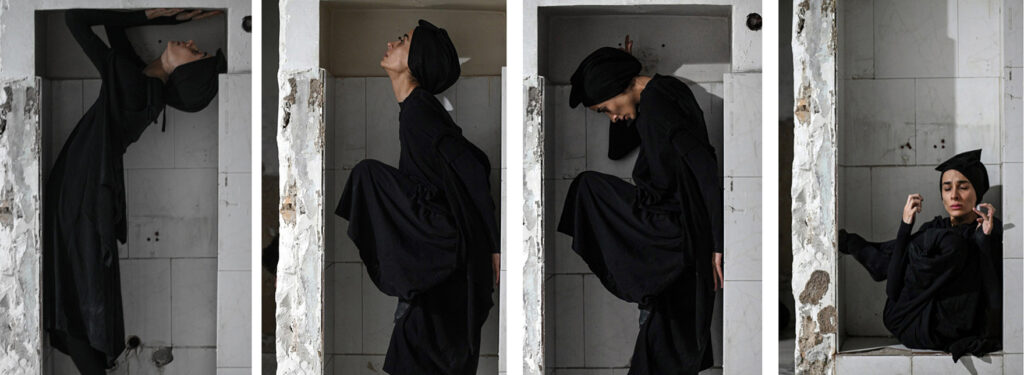
The choreographer of “People of Air scene”: Berkeh Bazri
Although most of the body of the work is made up of lingual possibilities and arrangements of scene elements; However, where none of these two elements are used, Dance will shoulder the responsibility of expression.

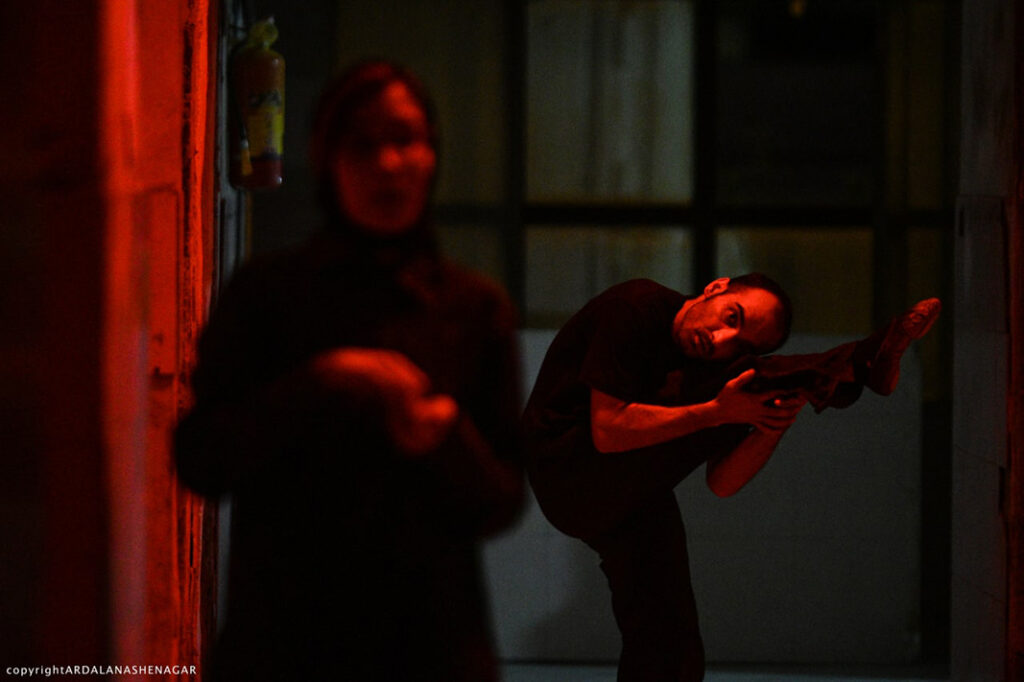
Two free dancers: Amin Shafie and Reza Tahmasebi
Although most of the body of the work is made up of lingual possibilities and arrangements of scene elements; However, where none of these two elements are used, Dance will shoulder the responsibility of expression.
Two performers danced freely on different floors. These two danced on the broken edges of the building, on the half-ruined walls or in the corridors and stairs, and they said their monologue in front of the audience from place to place while dancing.

On the blue floor was a small room where an installation of metal bells was made; This room was the nest of two free dancers in this piece. Whenever they wanted, they would crawl like free and happy animals, and the dancers would leave the room and go wherever they wanted on the blue and red floors. If the whole performance piece is like a book that is read in front of the audience, these two dancers were like the imaginations of the audience, which for a moment leaves the lines of the book and goes wherever it wants; like a lapse of concentration or maybe a daydreaming moment.
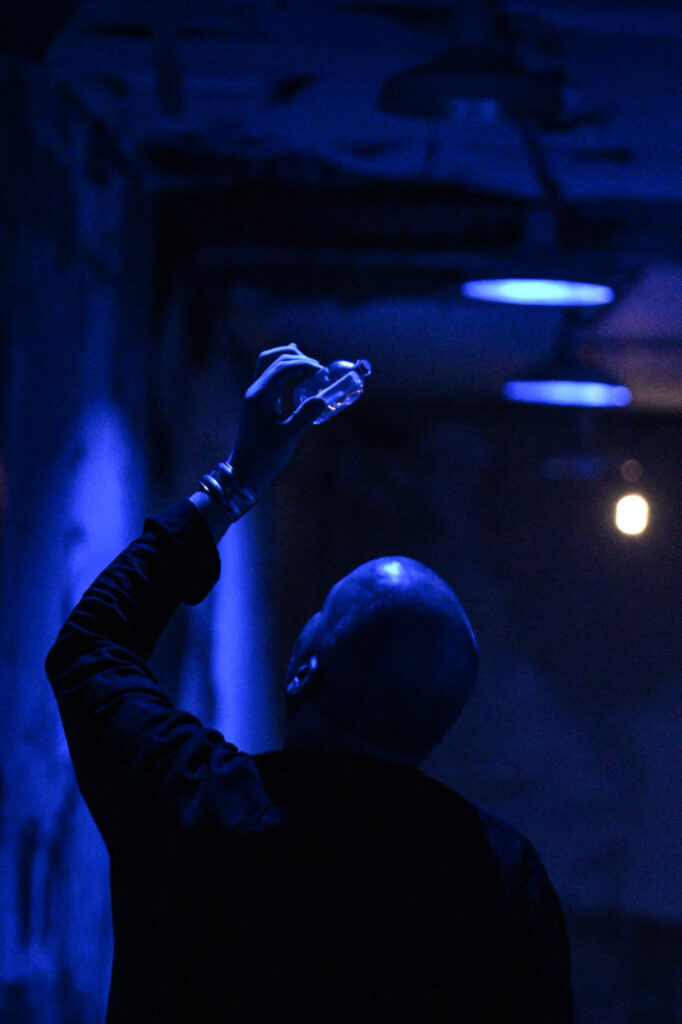
The Annotate: Ali Ettehad
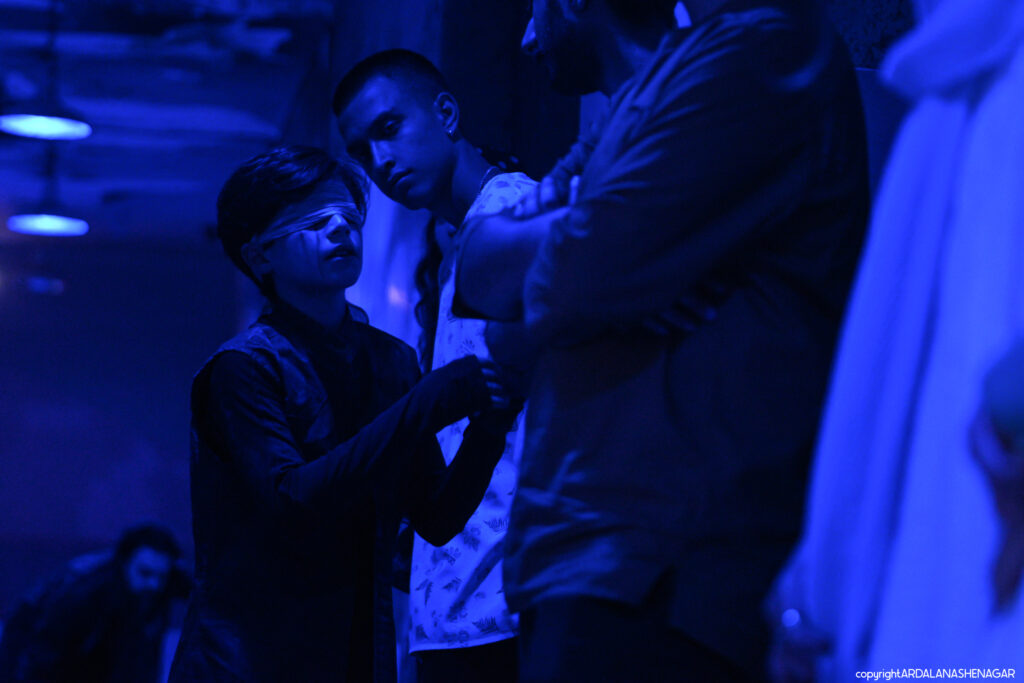
The Eyeless Child: Barsam Noori Oskooie
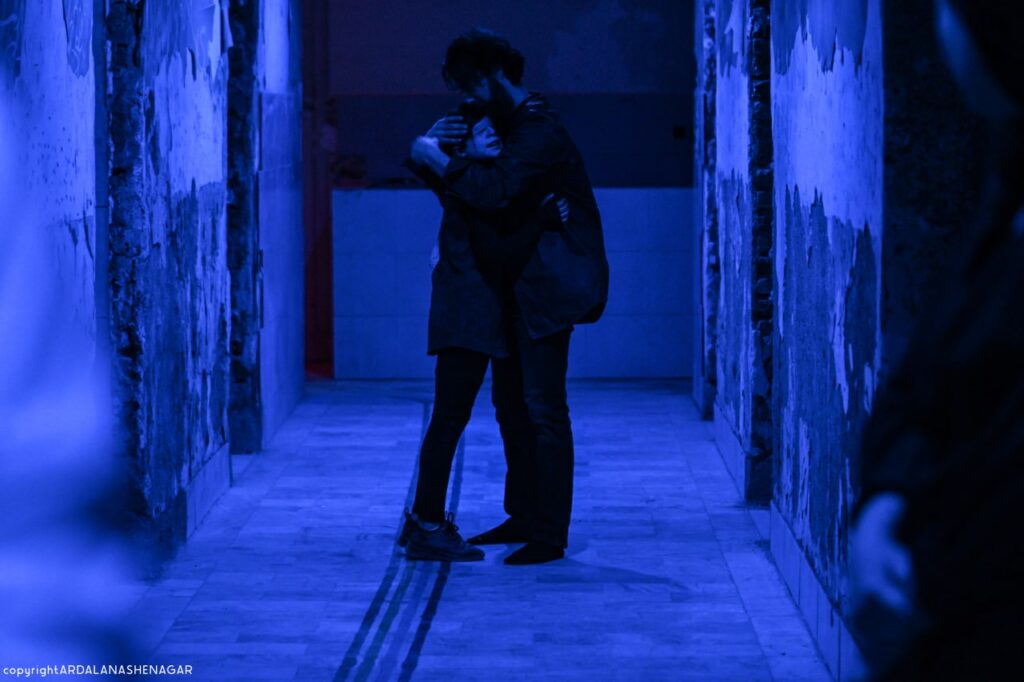
“The Glass eyed man” and “The Eyeless Child”: Parsa Ranjbar and Barsam Noori Oskooie

The performance on the blue floor begins with The Annotate’s monologue. At the end of this monologue, “The Glass eyed man” and “The Eyeless Child” come out of their room; These two are a single character; One of them recreates the time when the character is forty years old, the other shows the time when he was ten years old. The past, present and future are intertwined in this scene.



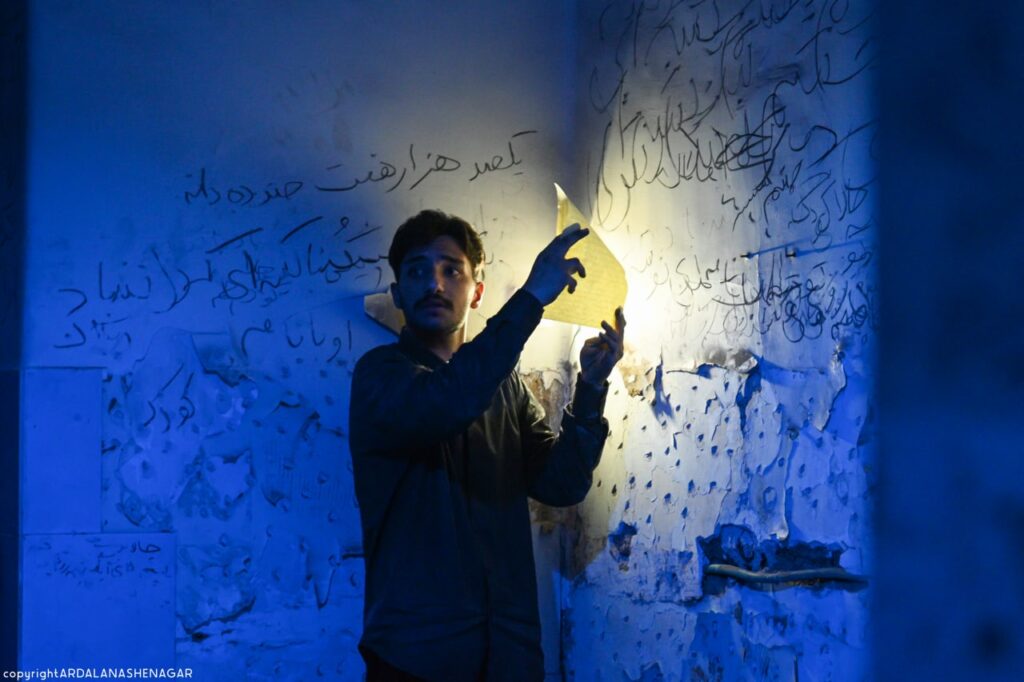
Performers of the Recitation Room (in the Blue Floor): Saeeed Babaie, Mohamad Hossein Rabie and Mohamad Sadra Delavari
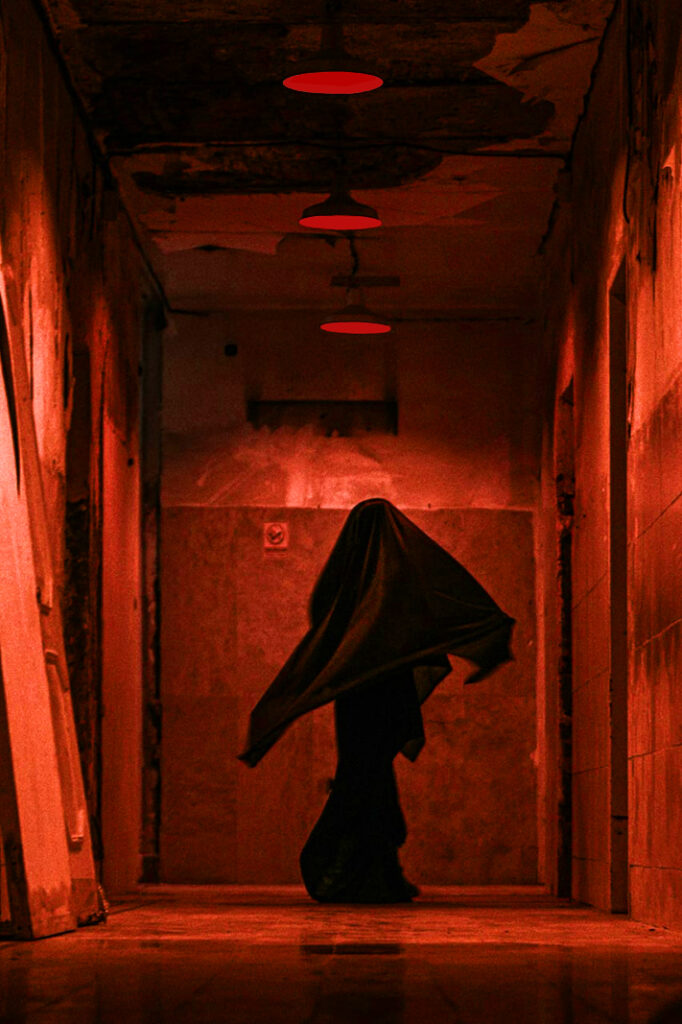
Dancer of the Red Corridor: Berkeh Bazri
When the audience reached the red floor, one of the performers was hidden under a black shawl and was lying on the floor. As soon as the last audience enters the red floor, the performer starts her monologue and slowly gets up under the black shawl without her face being seen and starts her dance. The movement of the black shawl was something like a puppet dance; A dance that was sometimes very soft and sometimes expressive. She took the audience with her through the red corridor to the “room of Jeweler and author”.
The room of Jeweler and author (in the Red Floor)


The room of Jeweler and author (in the Red Floor): Dariush Ahmadi and Atena Hosseini

The room of Jeweler and author (in the Red Floor): Romina Ador, Dariush Ahmadi and Atena Hosseini
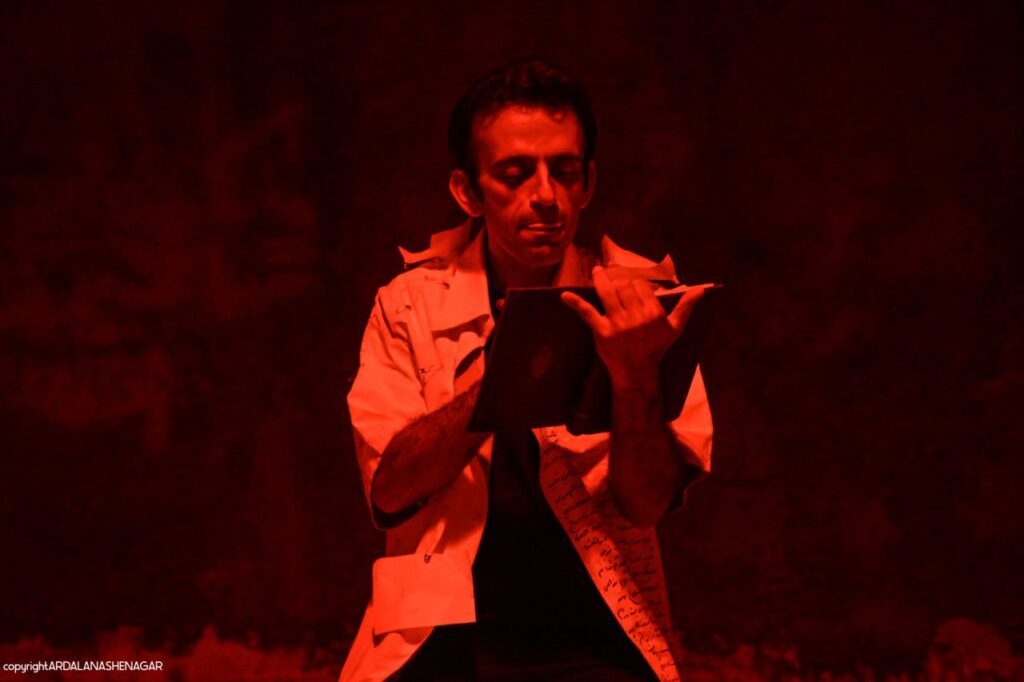
The room of Jeweler and author (in the Red Floor): Dariush Ahmadi

An installation: Right next to the jeweler’s room, there was a room whose walls and floor were covered with textiles and under the red light there was a stool and a typewriter on it, and the entire floor of the room was covered with scattered papers.

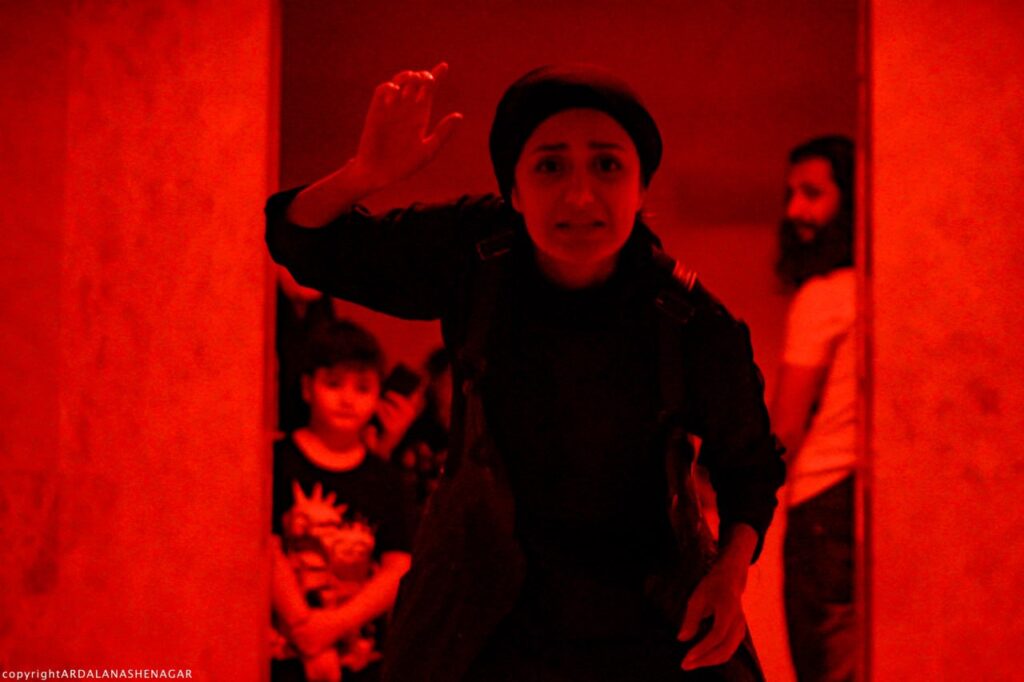

The Tailor (in The Red Floor): Melika Behjat
At the end of this scene, The Tailor comes out of her room and enters the jewelers and author‘s room and starts her monologue and slowly takes the audience to the her room.
The Tailor was reading a long poem in her room, which was full of cloth. This is a romantic poem about peace. The poem tells about a city that surrenders without any war and about catapults that are filled with rose blossoms and are shot towards the city so that it rains blossoms. The poem that The Tailor reads is about becoming one. In the middle of this, Saadi (a famous poet of the 13th century AD) enters the narration of the poem.
Let’s write a peace agreement.
Let’s remove the city wall.
You arm the catapults, slings and ballistas with rose blossoms.
I will get rose-water from them.
Saadi:
Do you know what I crave if I reach you?
Oh! Remembering you made me forget my dream.

The first page of Bustan by Saadi, from a Mughal manuscript.
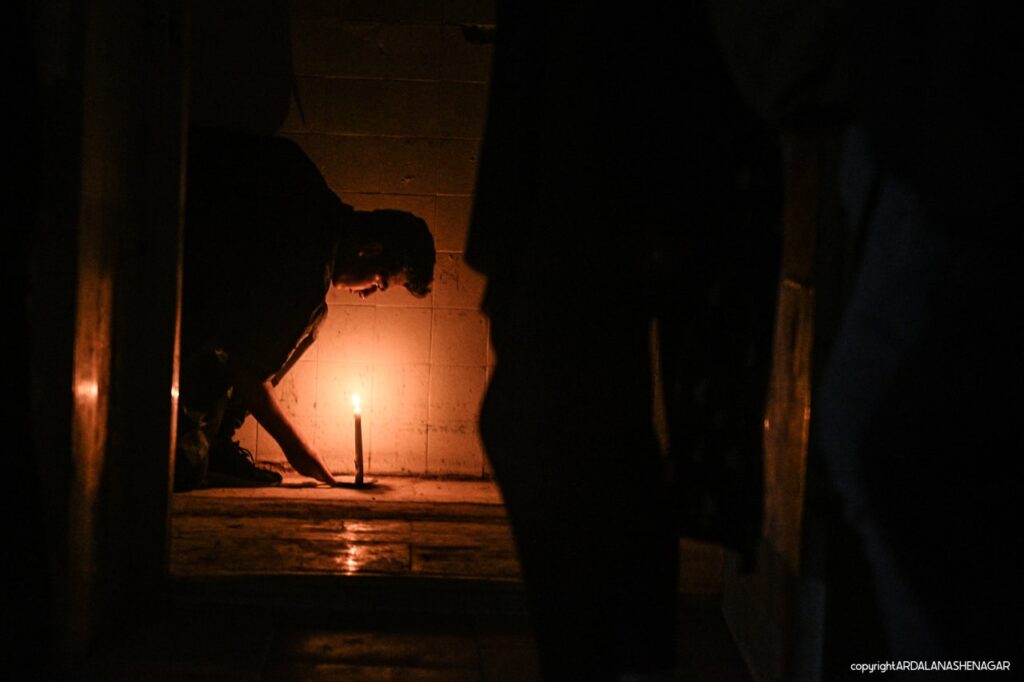
On of two Candlers: Parsa Maarefvand
The basement of the building was dark. This basement used to be the hospital’s warehouse and morgue. The audience who reached the basement encountered two performers moving along the walls on both sides of the corridor with lighted candles in their hands. The audience would pass through these two performers and reach the first room; “Spiders Room”.

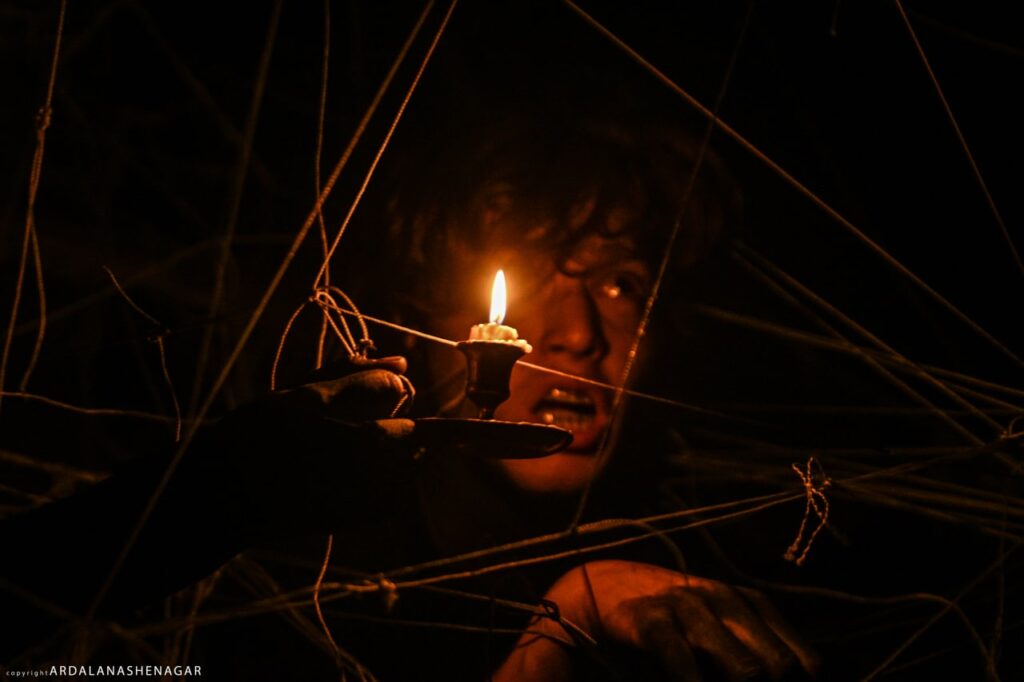

Performers of “Spiders Room” (in the basement): Nima Ghasemi and Sara Bolouri
In the basement, in a room where threads were tied between the walls and made the shape of a spider’s web; Two performers were performing a long dialogue. One of them was holding a lighted candle and the other was holding a thread. One of them would burn the installed threads with a candle and open his way, and the other would replace the burnt threads with new threads.


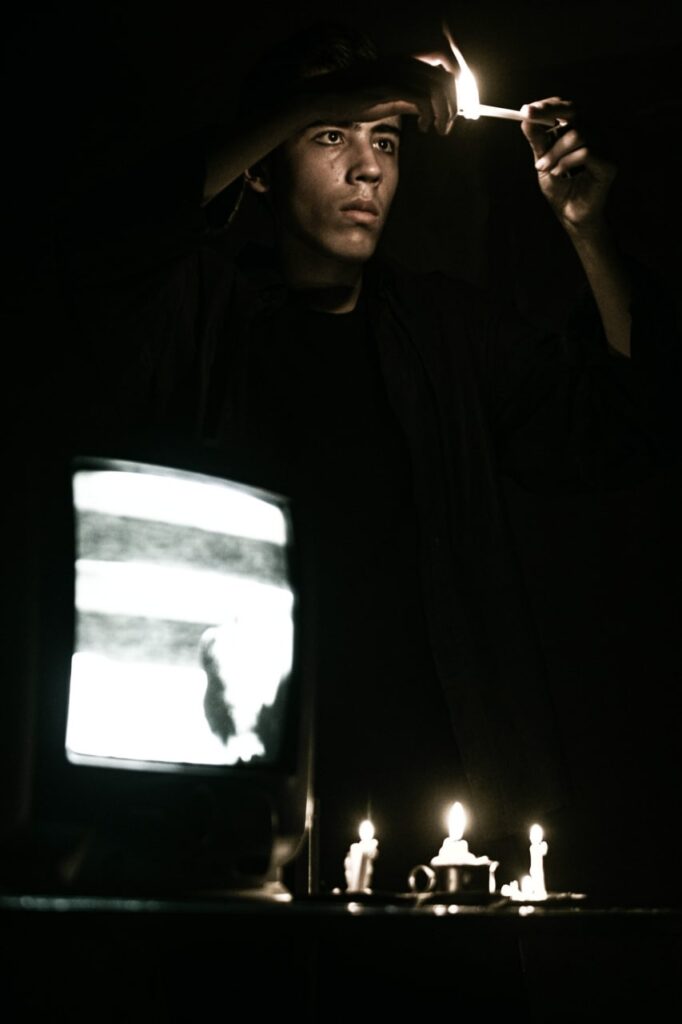
Hospital Room: Parsa Maarefvand and Farnood Hajiakhondzadeh
In the second room of the basement, there were two old televisions, one of which was playing a video of a conversation between a man and a woman in the hospital, and the other was television noise. Two performers (candlers) would take the audience with them to the hospital room and then each would speak a dialogue instead of one of the characters on the TV. The two performers performed the dialogues sometimes earlier and sometimes later than what was said in the video.
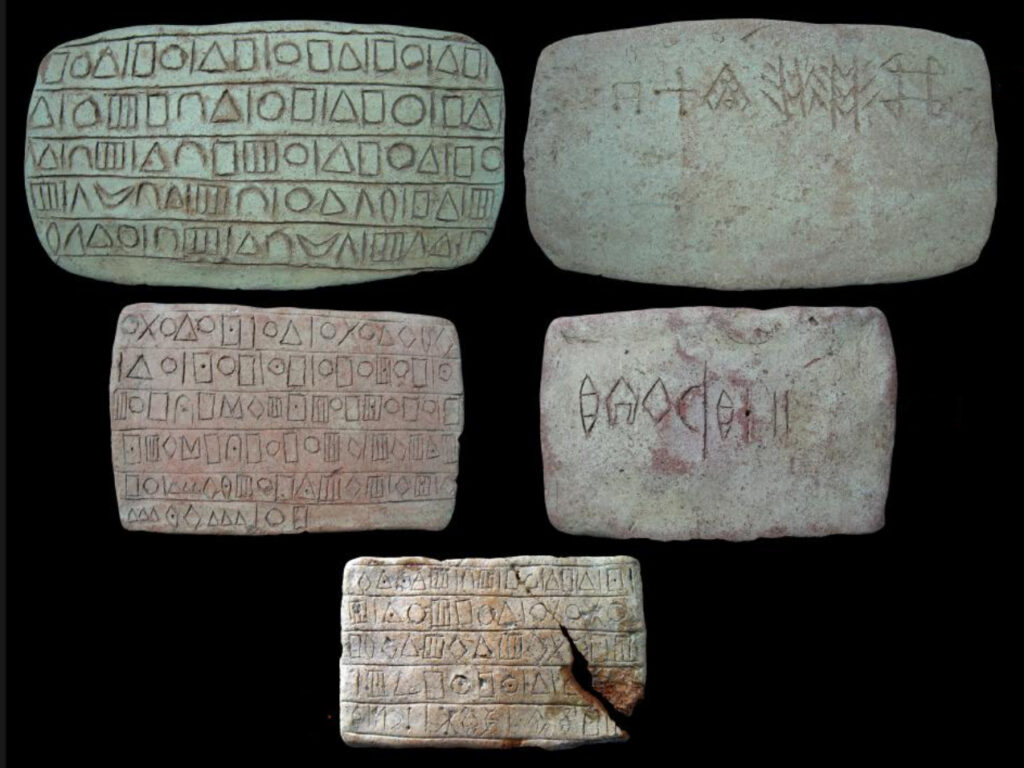
Jiroft culture inscriptions (read more)
Cyphers:
Some of the performers in this show were holding sheets of paper with things written on them, and the performers were reading things from that text. The text of most of these pages was selected from the ancient illegible tablets of the ancient Persia, and also some texts were designed in an unreadable form.
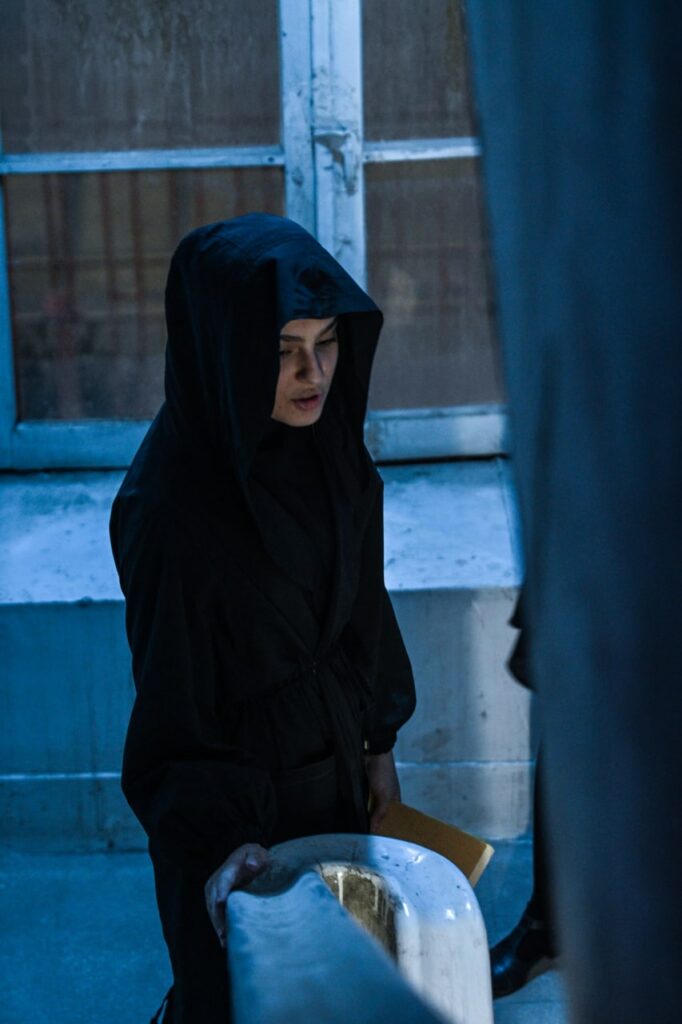
Letter reader: Dorsa Shahidi
“The Letter Reader” has a stack of letters in her hand, all of which are written in an unreadable script. She pretends to read the text from the cyphers and while reading, she takes the audience from the basement to the top.
After the audience saw the basement and three floors; “The Annotate” announced through a megaphone on the floors that “now is the time to go to the roof”. On the way to the roof from the third floor, the audience encountered “two children” who were holding hands and walking along the corridor of the third floor.

“Two children” simultaneously and loudly performed a text that is the description of one of the dreams of the main character of the narrative:
He has his eyes closed.
The sea is against him and also the wind is;
The wind that scatters salt and the infinite bitterness of the sea!
There are thousands of hymns in his head without words on his lips.
He closes his eyes and the sea recedes before them.
The sea recedes with every single wave.
and among the dry sands that remain; Columns, walls, doors and tents are rising.
And people – countless people – appear out of nowhere.
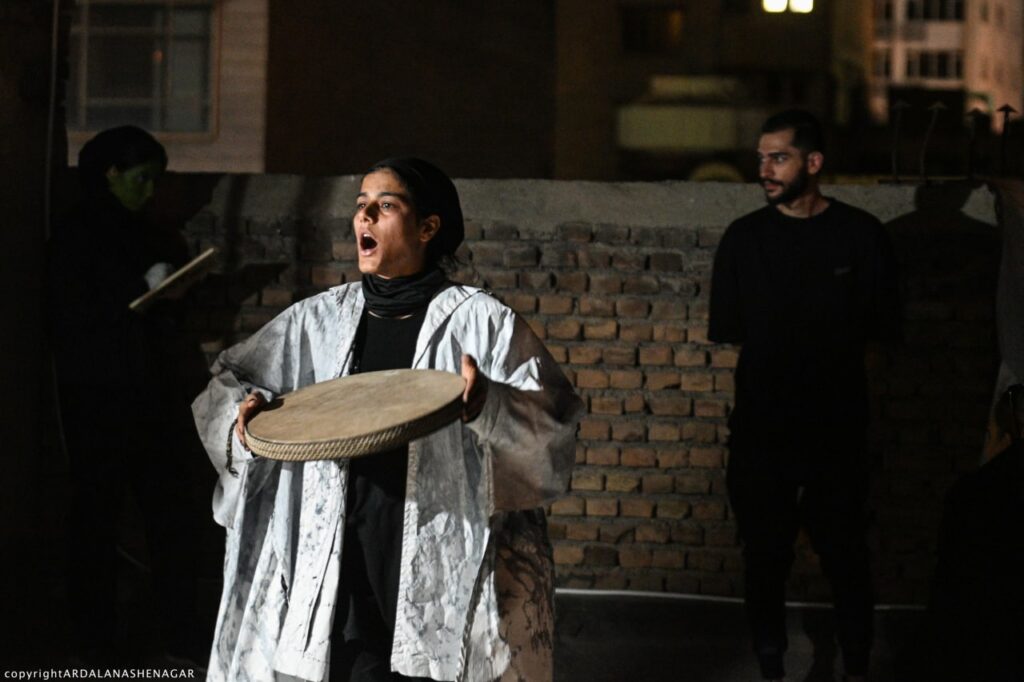


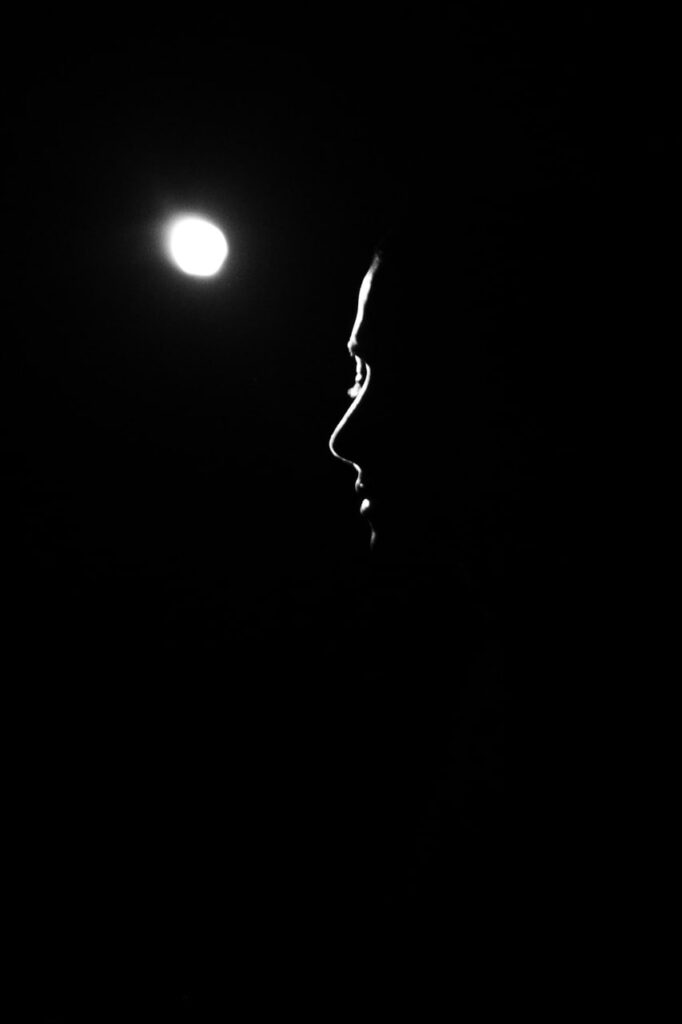
When the audience returned to the white floor; The lights were off. “The man with the envelope” stood in the corridor of the white floor and the light of his flashlight helped the audience to find their way. Then the “Red Corridor Dancer” entered the stage for the third time with a new outfit. This time she is the female half of the “The Writer”. Before the “Woman Writer” entered the final scene, the audience was sitting on chairs all around the hall and whispers were still coming from behind the walls. “Woman writer” would step on the stage and complete the story of the play. Then “The Performer of the Recitation Room” entered the stage holding the hands of the “two children”. From the middle of this monologue, “Man with envelope in hand” entered with his new persona “man writing”. These two performers would become one little by little until the story ends. Right at the moment these two performers become one; “The Lunatic” and “The Annotate” began to sing from behind the walls of the main hall. These two performers who had previously sung together on the stage of “ZĀR” and there their duet was something like a battle; Now they were singing like two mourners. “The Annotate” was holding a “Spring drum” and sung into it. At the end of this duet, when “Woman Writer” and “Man Writer” became one, “The Annotate” would give the spring drum to “Lunatic” and entered the stage himself to perform the closing sentences of the show. Now he no longer walked like the character of “The Annotate” nor did his speech resemble him; “The Annotate” has now become more similar to the writer and director of the performance; It was as if he was playing himself.

